Gestural Explorations in The Four Seasons
1. Setting the scene: The 1st movements
2. Poetic tableaus: The slow 2nd movements
3. Conclusions: The final movements
1. Setting the scene: The 1st movements.
The initial motifs in all of the first movements in The Seasons consist of eighth notes. The spring arrives marching merrily, with some hesitancy on the high quarter note, as if not completely confident whether winter is over (see Ex. 1 and Vid. 1).

Ex. 1 and Vid. 1 Illustrate the “hesitant” gesture on the third beat in the first two bars of the Spring concerto (Vivaldi, 1725).
In the Summer concerto, the eighth note motion is broken by pauses, blocking each bar with a wall of unbearable heat [1]. The body movement assimilates the sequences of movements and interruptions, which influences the timing of the phrases (See Ex. 2).

Ex. 2 The “V” markings represent a hindrance, stopping the forward motion represented by the arrows, in the opening bars of the Summer concerto (Vivaldi, 1725).
Both in the Spring and Summer concertos the first solo entrances represent birdsong. While in Spring, the atmosphere remains pleasant, in Summer ‘the cuckoo’s voice is a premonition of a disaster’ (Everett, 1996, p. 83). It is not obvious how to imply different birdsongs and moods in body movements. Rather than attempt to 'represent' different birds, I instead let my body react to the mood triggered by different poetic imageries. In Spring, I reach towards the birdsong, look up, and follow the sound. With the ominous cuckoo, I turn away and await my destiny.


Ex. 3 The birdsong in the Spring concerto, bb. 13-17 (Vivaldi, 1725).

Ex. 4 The cuckoo in the Summer concerto bb. 30-31 (Vivaldi, 1725).
Vid. 2 The various birdsongs in the Spring and the Summer concertos.
The initial eighth note motif of the Autumn concerto reveals a vigorous dance of drunken rustics. There is no hesitation or insecurity in this movement, as we find in the beginning of Spring. The unexpected dominant 7th chord on every fourth eighth note represents clumsy dance steps, or rather tripping, caused by Bacchus’ wine.
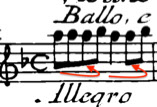
Ex. 5 and Vid. 3 The opening bar of the Autumn concerto, where the B-flat eighth note step clashes dissonantly against the bass, creating the sensation of a drunken dance (Vivaldi, 1725).
The drunkenness is rapidly getting out of hand. Vivaldi sets the scene by juxtaposing a soloist and the orchestra, where the soloist is the drunkard disrupting the party. In the first solo, the drunkard just mimics the ritornello. Silencing all the other violinists, the soloist takes on the dance tune in awkward double stops.

Ex. 6 The soloist mimicking the opening ritornello in the first movement of the Autumn concerto, bb. 18-21 (Vivaldi, 1725).
The dance steps do not seem to obey the drunkard; he bounces into other guests, who, as if embarrassed, reiterate only a fragment of the theme. The tension between the soloist and the orchestra is represented in their body movement.
Vid. 4 Drunkard disrupting the party.
The drunkard (the soloist), realising (s)he is being ignored, launches a passionate tirade of rubbish, consisting of F major up-and-down arpeggios and scales. The other guests (the orchestra) attempt to play the dance tune, but yet again they are interrupted by the drunkard.


Ex. 7 & Vid. 5 Push-and-pull between the drunkard (the soloist) and the guests at the party (the orchestra) in the first movement of the Autumn concerto bb. 32-34 (Vivaldi, 1725).
And it is just getting worse. Luckily, in the moment when the confused situation is about to turn into a fight, the drunkard falls asleep, in the middle of a sentence.
Vid. 6 The drunkard is getting into a fight, but falls asleep.
The Autumn concerto gives us an interesting hint about the role of the sonnets in the compositional process. In bar 32, at the second entrance of the 'drunken' soloist (Ex. 7), the cue-letter 'B' in the Manchester manuscript copy (pre-dating the 1725 print) refers to the Sonnet line:
E del liquor di Bacco accesi tanti
Finiscono col sonno ill or godere. [1]
The mild wording of the sonnet, implying a merry, drunk company enjoying wine, is in contrast with the obvious incoherence of the musical structure, especially between the solo part and the orchestra. Bars 39 and 40 in Ex. 8 below suggest that the orchestra (the other guests at the party) is trying to ignore the revelry of the soloist (the drunkard). Twice, they attempt to reinstate order by bringing back the dance tune, but both times they are vigorously interrupted.
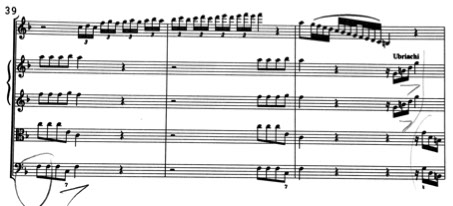
Ex. 8 The incoherence in the musical structure may imply an annoying drunkard disrupting a party, in the first movement of the the Autumn concerto, bb. 39-44 (Vivaldi, 1725, Dover score, 1975).
Vivaldi must have realized the discrepancy between the somewhat generic imagery in the Sonnet and the rather more burlesque version suggested in the musical structure. When preparing a new version of Seasons for the 1725 print, he adds the annotation 'Ubriaco' to bar 32 of the solo violin part. By distinguishing between Ubriaco as singular (bb. 32-41) and Ubriachi as plural (the caption is added only in the middle of bar 41 in the orchestral parts), Vivaldi resolves the ambiguity to the advantage of the musical structure. The caption specifies the implication of the Sonnet: the Ubriaco (a single person) disrupts the party in bar 32. The others, not yet drunk, try to ignore the annoying drunkard. Only in bar 41 do the remaining guests get drunk enough to deserve a caption Ubriachi from Vivaldi. A heated confrontation arises, but is suddenly brought to a halt, as the drunkard falls asleep in the middle of one of his nonsensical sentences.

Ex. 9 L’Ubriaco falls asleep as if in the middle of a sentence, in the Autumn concerto bb. 87-91 (Vivaldi, 1725).
So again, did the Sonnets or the music come first? Fortunately, in this thesis, it is not necessary to resolve this issue. But it is intriguing to observe that in general, the music lifts the mediocre Sonnets to further heights of artistic expression [2]. A Gesturist will explore the affordances in the musical structure through body movement, even if they are not explicitly indicated in the Sonnets and in the additional annotations.
The strange drunken figures in the Autumn concerto trigger the imagination and lend themselves to a spontaneous enactment of a similar interaction between the players. If this movement is played without the implied conflict between the soloists and the orchestra, a dull performance is the likely result. The interaction is essential and also draws musical qualities out of the score: ‘It is no coincidence that Autumn elicits from the soloist the Seasons’ most sustained displays of extrovert virtuosity, for in this way man’s brash confidence is superimposed on our perception of the depicted events’ (Everett, 1996, p. 86).
Vivaldi’s 'on-the-edge' treatment of the solo part in the Autumn concerto makes it a special moment in the performance of the complete cycle. At the same time, when only one of the concertos of the Seasons is selected for a concert program, the choice rarely falls to the Autumn concerto. Outside of the context of the whole cycle, the soloist risks sending the 'wrong' message to the audience, by being 'clumsy and drunk' in the first movement, 'hunted down' by the orchestra in the last movement, and 'being asleep' in the slow movement without a single solo passage.
Rather than marching, the frosty eighth notes of the Winter concerto seem to rise from within the players, seeming, according to the Sonnet, ‘to shiver, frozen, amid icy snows’ (Everett, 1996, p. 75).

Ex. 10 The opening bars of the Winter concerto (Vivaldi, 1725).
A horrifying sul ponticello sound [3] combined with clashing dissonances seem relentless. To overcome the frost, the obvious resort is ‘to run, stamping one’s feet at every moment’ (Everett, 1996, p. 75).

Ex 11 The motif of running and stamping one’s feet, bb. 22-23 in Vivaldi’s Winter concerto (Vivaldi, 1725).
Vid. 7 Shivering and stamping of the feet in the Winter concerto.
The notation of the two-and-two slurred eighth notes with staccato dots will urge an HIP performer to consult the historical sources. What articulation and application of the bow are historically appropriate?

Ex 12 Dotted and slurred eighth notes in the opening bars of the Winter concerto (Vivaldi, 1725).
Leopold Mozart advises that dotted notes lying within the slur ‘are not only to be played in one bow-stroke, but must be separated from each other by a slight pressure of the bow’ (Mozart, 1756, p. 45).
A Soundist applies the advised bow-stroke, and, by drawing the bow close to the bridge, creates a ponticello effect, in order to evoke a frozen quality in the sound. In my gestural experiments, following the Sonnet’s initial line, Aggiacciato tremar trà nevi algenti [4], I attempted to assimilate the repeated eighth notes as a shivering body. The coordination in the ensemble is normally achieved through movements based on common pulse. Even though such a method is obviously more exact and reliable, we attempt to transcend a pulse-based structure by assimilating the shivering, frozen bodily movements into playing action. The sound producing bow movement, now less rhythmically distinct, is triggered and coordinated by shivering bodies.
Vid. 8 In this video example, the bow action is triggered by shivering body movements.
See further discussion on the relationships between instrumental technique, historical practice and the Gesturist strategy of embodied reading of musical scores in Section V3bT2 below.
2. Poetic tableaus: The slow 2nd movements.
The slow movements in the Four Seasons are often described as atmospheric tableaus, or as songs without words (Everett, 1996, p. 62), implying some poetic relaxation in-between the surrounding, eventful, fast movements. As the soloist is busy with shaping the lyrical melody, it is often the accompaniment that sets the character and the emotive content. ‘Vivaldi normally provides a mesmeric mono-figurative accompaniment that is more evocative than the melody itself’ (Everett, 1996, p. 60).
Three of the four slow movements mirror the character or poetic imagery of their respective outer movements. Only Winter seems to establish a contrasting atmosphere, but as we will see below, it is foretelling the final happy ending of the last movement.
The accompaniment in the Largo of the Spring concerto is designed as a ‘figurative representation of the murmurings of leafy branches and plants’ (Everett, 1996, p. 62).

Ex. 1 The murmuring motif at the beginning of the Largo in the Spring concerto (Vivaldi, 1725).
In the background, a dog is barking sempre molto forte e strappato (very loud and separate), represented by the viola. The melody on top represents a sleeping goatherd, dreaming of his beloved. From the gestural point of view, it is the 'barking' viola player that employs the most active movements, while the atmospheric murmuring of the hushed violins and the pleasant dreaming of the soloist evoke peacefulness and longing.

Ex. 2 The barking dog played by the viola in the Spring concerto (Vivaldi, 1725).
The melodic line is drawn from the harmonic context. Twice, the G-sharp major chord triggers the melody to climb into the high third of the E string, reaching B-sharp, the leading note to the tonic C-sharp. The first time the melody fails to reach the top C-sharp. Only the second time, as an emotional culmination, is the C-sharp reached, resolving the harmonic tension.
a)  b)
b) 
Ex. 3 The trajectory of body movements supports the melodic contour, bb. 4-6 and 27-30 in the 2nd movement of the Spring concerto (Vivaldi, 1725).
In lacking a specific narrative, the body movements of a violinist will express the general poetic image and melodic contours, and reflect the harmonic tension. Ex. 3 above illustrates the relationship between the body movements and the melodic and harmonic structure, as can be observed in the video Vid. 1 below.
Vid. 1 Body movements reflecting the melodic and harmonic structure.
The accompaniment in the Adagio of the Summer concerto has a similar design to the Largo of the Spring concerto, with dotted figures in the violins. But instead of sweet murmuring of fronds and trees, the soloist is attacked by a ‘furious swarm of flies and blowflies’, depriving ‘his weary limbs of repose’ (Everett, 1996, p. 73).

Ex. 4 The accompaniment in the Adagio of the Summer concerto (Vivaldi, 1725).
The representation of the annoying flies will require a different sound than the murmuring of the fronds, possibly the ponticello effect (close to the bridge) that we encountered in the opening of the Winter concerto. Apart from the sound, we attempt to differentiate the kinaesthetic implications of representing the annoying insects on the one hand, and the gentle motion of the leafy branches on the other.
Also, the melody in the Adagio of Summer is different to the sweet dreaming tune of Spring. Full of worries and premonitions, the melodic line of Summer is continuously interrupted by the distant thunder of an approaching storm.

Ex. 5 The melodic line implies worries in the Adagio of the Summer concerto bb. 5-6 (Vivaldi, 1725).
The thundering interruptions are getting louder and louder, anticipating the approaching storm.

Ex. 6 The approaching storm in the Adagio of the Summer concerto bb. 8-9 (Vivaldi, 1725,).
Vid. 2 An excerpt from the Adagio of the Summer concerto.
To differentiate the body movement strategies in these two contrasting poetic tableaus, the continuous line of the sweet and dreamy Spring might be drawn from a dance form, possibly the Sarabande; while the hesitant melodic line of Summer can be embodied as a lamenting aria, as if pronouncing words like morirò, disprezzato, pòvero [5], or similar emblematic words associated with desperate laments.
Vid. 3 “To dance or to sing…” A comparison of body movement strategies between the slow movements of Spring and Summer.
The poetic imagery in the second movement of the Autumn concerto, Adagio molto, represents the unruly sleep of drunkards (Ubriachi dormenti). The only sign of life is the arpeggio chords of the harpsichord that may represent heavy breathing, and some unexpected harmonic clashes, as if the sleeping bodies move reflexively, triggered by a nightmare. Vivaldi is consistent in the choice of melodic material. The pattern of a long note followed by two descending steps of quarter notes is also used in his other 'sleeping scenes' [6].

Ex. 7 The melodic line of the sleeping drunks never settles, in the 2nd movement of the Autumn concerto bb. 6-12 (Vivaldi, 1725).
As for the concerto form, the most radical feature of this movement is the fact that the company of drunkards is so deeply immersed in slumber, that not even the soloist succeeds in playing a tune. When the hunting signal of the 3rd movement wakes the peasants up, it is too late, and the slow movement of Autumn remains solo-less.
Gesturally, the sleeping mode comprises a challenge. The body movements must keep moving to produce the sound, but by resisting to 'move forward' or 'phrase towards a goal point', a static motionless effect is achieved. Interestingly, the visual effect without audio gives the impression of a slow-motion film.
Vid. 4 The slow movement of the Autumn concerto representing the drunkards’ sleep.
After the shivering and freezing ‘amid icy snows’ of the first movement in the Winter concerto, the sonic spectrum of the second movement is rather surprising. ‘There can be few musical experiences as satisfying as hearing the slow movement begin. The dark warmth of E-flat major is the perfect welcome, quickly bringing us indoors and shutting out F minor’s grey chill’ (Everett, 1996, p. 88).
As in the previous slow movements, it is the accompaniment that generates the expressivity and charm of the aria-like melody. The onomatopoeia of raindrops in the pizzicato violins, the burning wood in the fireplace represented by arpeggio figurations in the cello, the long notes in the violas amorously embracing the solo melody – all this creates a most beautiful poetic imagery in sound.
Looking at the score, the musical structure does not look promising for a sworn Gesturist. The melody, locked in a web of symmetrical pulsation constructed across several metrical levels, consists predominantly of dactylic rhythmic patterns. The structure lacks a palpable narrative or a sufficient 'space' for dancing. What, then, are the gestural affordances in the given poetic imagery?
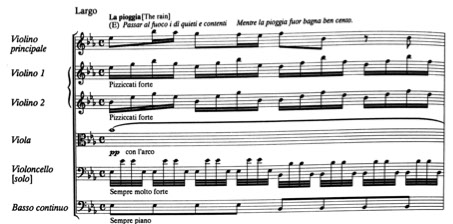
Ex. 8 A cobweb of different figures in the beginning of the Largo in the Winter concerto (Vivaldi, 1725, Dover, 1975).
It seems that rather than forcing any Gestural agenda, one may simply let go and give in to the seductive richness of the sonic pallet of colours and shapes. After the recent projects, and some fifteen performances, this movement seemed to breathe best when the body movements were woven into the sonorities. The section comprising the artistic projects of this thesis is entitled ‘From Gesture to Sound’, implying that sound may be drawn from embodied assimilation of gestures, dance movements, or poetic imagery. The Largo of the Winter concerto can be considered as an epitome of the merging of sound producing and expressive movements, where a gesture becomes a sound and sound becomes a gesture.
Vid. 5 From the 2nd movement of the Winter concerto.
3. Conclusions: The final movements.
If Spring arrived somewhat hesitantly in the first movement, in the third movement the nymphs and shepherds lose themselves in a rustic dance accompanied by bagpipes. While the upper voices mix Gigue and Siciliano rhythms,

Ex. 1 The dance structure of the Gigue in bb. 1-2 of the Spring concerto’s last movement (Vivaldi, 1715).
the basses and violas create a bagpipe effect by the shaping of the long notes. Returning again to the terminology employed in the previous section, we can establish a more in-depth understanding of these traces of movement by discussing how the arsic and thetic relation between dance steps can be applied to musical structure.

Ex. 2 The bass part of the village dance based on the bagpipe drone in bb. 1-6 of the last movement of the Spring concerto (Vivaldi, 1725).
To enhance the rusticity of the dance, the arsic and thetic relationship in the metric structure of a bar is represented by two energetic body movements. The robust lift on the downbeat bounces in the middle of the bar.

Ex. 3 A rustic lift and bounce in the first two bars in the last movement of the Spring concerto (Vivaldi, 1725).
The lively step-unit of the proper Gigue would employ a more elegant èlevè and landing.

Ex. 4 Arsic and thetic distribution in the Gigue structure (Vivaldi, 1725).
The distribution of arsis and thesis would also be more detailed and refined in the Gigue, comprising an interplay of four lively steps.
Reducing the four arsic and thetic accents in a bar to only two accents will have a special kinaesthetic effect on the body movements of the performer. As there is more time the movements get larger, with a greater energetic impact, and, not least, with greater rusticity in their character.
Vid. 1 Opening bars of the last movement in the Spring concerto.
When representing a rustic dance, the performers tend to make stronger and more frequent accents, even in figures at the smaller metric level. Even though there is no harmonic reason to accentuate the second beat of the first bar, I often encounter such treatment in the orchestras I visit. The process of 'de-accentuation' is always very interesting and unfolds in several stages. Let’s say that my two-accents-in-a-bar strategy is accepted. To comply with the strategy, the players only accentuate the downbeat and the middle of the bar. The second and forth beats have a distinctly softer dynamic.
So far so good. But for a Gesturist, it is not the marking of the notes in sonic accentuation that creates a gesture. While the players sonically accentuate only two beats in a bar, they still move four times, as every move of the bow, even the un-accentuated ones, triggers body movement. At this stage, a little Gesturist exercise always helps. Rather than focusing on the bow, we monitor the body movements. Two movements occupy the whole bar, like two swings of a pendulum, from left to right and back. The downbeat and the middle of the bar coincide with the pendulum’s (the body’s) swinging close to the floor; the unaccented second and forth beats occupy the moments of inertia on the swings high right and high left.
Video example 2, below, captures a similar process of “embodied de-accentuation”.
Vid. 2 An embodied realization of the dance structure in the opening of the 3rd movement in the finale of the Spring concerto.
Turning to the lower voices we should consider that the bagpipe cannot produce an even sound, but instead produces some intentional, and some random, rhythmical structures that arise from the technology of its sound production. In the opening bars of the finale, the cellos and violas experiment in applying various shapes to the long notes. To match the dance structure in the upper voices, the long note must peak in the middle of the bar.
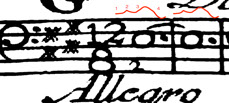
Ex. 5 The shaping of the long notes in the basses and violas in the last movement of the Spring concerto bb. 1-2 (Vivaldi, 1725).
Rather than shaping the long note by bow pressure, we attempt to employ body movement patterns. While drawing a long and steady bow-stroke, the body movements of the bass player reflect the movements of the violinists. Assimilating the dance energy in body movements will imbue the long note with movement and direction, even without specific sonic accents.
Vid. 3 Finding the shapes of the long notes in the beginning of the finale of the Spring concerto (Vivaldi, 1725).
The wild village dance in the last movement of Spring has an interesting gestural overlap with the 'drunkenness' in the first movement of the Autumn concerto. Celebrating the spring, the villagers’ dance is getting wilder and wilder.

Ex. 6 & Vid. 4 The dance is getting wilder and wilder in the last movement of the Spring concerto bb. 40-43 (Vivaldi, 1725).
Even though the Sonnet is not specific about drunkenness, the cadential passage implies it strongly.

Ex. 7 & Vid. 5 The body movements of the drunk shepherd are getting heavier and heavier, bb. 73-75 (Vivaldi, 1725).
In comparison with the 'annoying' drunkard of the Autumn concerto, who destroys the party, the shepherd of Spring is drunk, but friendly, and even a bit embarrassed at the end.
The storm in the last movement of the Summer concerto might sound like a straightforward ensemble action, but it consists of many disparate motifs and surprising interactions that demand proper coordination. The explosiveness of the accents, and the push-and-pull action between the players, make this opening one of the most exciting moments of the whole collection.
The movement begins with a powerful ensemble unison, thundering the four-note descending leitmotif embedded in the repeated sixteenth notes.

Ex. 8 Unison opening of the 3rd movement of the Summer concerto bb. 1-4 (Vivaldi, 1725).
The notation of the storm will recall a similar effect of iterative sixteenth note passages in Telemann’s Windmills attack and Monteverdi’s Combattimento (See the discussion of the concitato style in V1bT2 The sixteenth notes 'in the combat’).
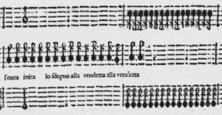

Ex. 9 'Concitato' style, in which reiterations of sixteenth notes creates the excitement of battle, is claimed by Monteverdi in his Il Combattimento (1638) to be his own invention. Telemann uses a similar effect in Son attaque des moulins à vent, bb. 5-6, (17??).
Even the gestures employed in the performance of Vivaldi’s storm will be similar to those employed in Telemann’s sword fighting. The body movements assimilate the imagery of the Sonnet:
‘The sky thunders, flares, and with hailstones
severs the heads of the proud grain crops’ (Everett, 1996, p. 73)
The jolting body movements follow the descending melodic line representing the roaring of thunder.

Ex. 10 & Vid. 5 The opening of the last movement in the Summer concerto, with the circles representing the jolting body movements and the arrows marking the gathering of energy that culminate in the last bar (Vivaldi, 1725).
A disruption of the gestural discrepancy in the initial bars proceeds in three stages. First, the destructive hailstones divide the violins, which compete in ferocity with downward scales.

Ex. 11 & Vid. 6 The hailstones in the violins bb. 14-15 (Vivaldi, 1725).
Then, the rising eruptions in the violins (Ex. 11a) clash with the lightning figurations in the violas (Ex. 11b). Meanwhile, the threatening four-note thunder motif is now roaring in the bass instruments (Ex. 11c).
a)
![]()
b)
![]()
c)

Ex. 12 & Vid. 7 The contrasting figures in the last movement of the Summer concerto bb. 23-25 (Vivaldi, 1725).
When all the gestures come back together, it is hardly a peaceful encounter. In the culminating energy of the sixteenth note bariolage, occurring simultaneously in all instruments (bb. 32-38, the octaves in the basses are technically close to impossible) we perceive ‘an unprecedented representation of destructive power’ (Everett, 1996, p. 83). The earth is now shaking, and all is set for one the collection’s most virtuosic solo passages, the lightning (analysed in a video essay in Section V3c 'Summer lightning').
a)
![]()
b)
![]()
c)
![]()
Ex. 13 The bariolage passages in all instruments (a, violins, b, violas, c, basses), in the finale of the Summer concerto bb. 32-34 (Vivaldi, 1725).
In the following video example from a rehearsal, I explore the process of coordinating the disparate gestures in the opening of the finale in the Summer concerto.
Vid. 8 Rehearsing the coordination of the opening of the 3rd movement in the Summer concerto.
For a comparison, the next video example captures the same section again, but this time from a performance, where the storm becomes 'real'. While in the rehearsal the gestures are enacted within the context of a common pulse, with a focus on precision, in the performance the gestures transcend the referential regularity of the pulse, with a coordination of expressive gestures in direct interaction. Each gesture projects a kinaesthetic shape, allowing both the triggering and receiving of energetic impulses. Timing based on the direct interaction of gestures enhances the expressivity of performance. Thus, even a seemingly simple musical structure can afford a complicated gestural choreography in the performance. I discuss further the shared space of interpretation between the agencies of performer and composer in Section V3dT1 The composer 'in my way'.
Vid. 9 The storm in performance.
The Autumn concerto’s last movement introduces two motives recognizable as hunting signals. As in the first movement, the soloist enters in double stops, imitating the second hunting motif.

Ex. 14 Hunting motif in double stops in the finale of the Autumn concerto bb. 30-31 (Vivaldi, 1725).
Sleeping off the drunkenness of the preceding slow movement, the former drunkard now seems to be accepted back into the community, joining the peasants for a hunt. But what unfolds from the third solo entrance makes him wonder. Surely this can’t be real, isn’t this just a nightmare, arising from the unruly sleep of the 2nd movement? The guns of the peasants (the orchestra) are turned against the animal (the soloist) and they 'mean business'!
‘The band contributes important phrases of articulation in the form of bursts of gunfire’ (Everett, 1996, p. 87). In the performance, we attempted not only to represent the gunshots in sound (sharp violent accents, 'Bartók' pizzicato where the string hits the fingerboard), but also to enact the shooting gestures and spatial distribution of agents in the hunting scene. The band follows the track of the fleeing animal (me),
‘already bewildered, and wearied by the great noise
of the guns and dogs…’ (Everett, 1996, p. 75).
And the moment they spot me, the gunshots resound without mercy…
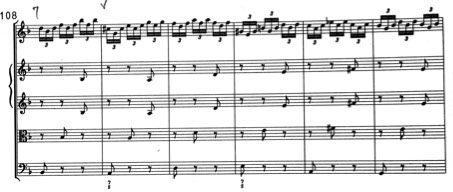
Ex. 15 The wild beast flees the gun shots in the finale of the Autumn concerto bb. 108-113 (Vivaldi, 1725, Dover score, 1975).
Thus, the last movement of the Autumn concerto complements the first movement through parody. The interaction of gestures, where the 'terrified' soloist attempts to escape and hide from the 'blood-thirsty' orchestra, contributes – apart from the visual, theatrical element – also to the expressive temporal realisation of the musical structure. Even though the gun shots are situated in the regular 3/8 time, the embodied action of firing the gun transcends the regularity of the pulse and make the individually fired shots appear as random independent events.
Vid. 10 The orchestra attempting to 'shoot' the soloist.
The introduction of the last movement in the Winter concerto does not promise any relief from the threatening character of the first movement. After a poetic slow movement, the scene in the finale is set for a surrealistic path across a frozen lake. The first twenty bars of violin figurations above a cello’s tasto solo (without any realization of the basso continuo) implies being abandoned and an unwillingness to take the first step on the ice.


Ex. 16 The opening bars of the last movement in the Winter concerto (Vivaldi, 1725).
Indecisiveness is also implied in the body movements of the violinist. The long F in the bass might never end (Vivaldi’s indication says arcata lunghe e tasto, asking to apply a calm bow action on the long notes), and the figurations lead to the only possible option, to walk on the ice of the lake.
Vid. 11 The tentative attempt to make the first step onto the frozen lake.
As soon as the foot touches the ice, the earth starts turning around and all balance is lost.
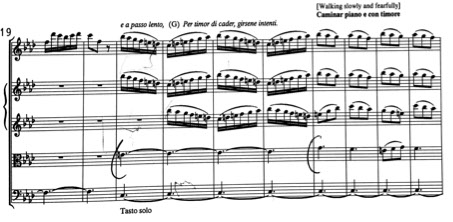
Ex. 17 Losing balance while walking on the ice in the finale of the Winter concerto bb. 19-28 (Vivaldi, 1725, Dover, 1975).
Walking becomes running, but suddenly, not far from the shore, the ice starts to crack. The body is tossed from side to side until the inevitable fall, all the way from the top of the high C to the lowest note on the violin, the open G string. At this point, the reference to the sonnet introduces the 'M' line which says: ‘The ice cracks and breaks open.’

Ex. 18 & Vid. 12 The stumbling and falling figure in the finale of the Winter concerto bb. 95-99 (Vivaldi, 1725).
The south wind (Vento sirocco) comes to the rescue, quoting the thematic material from the opening the Summer concerto. This time, the warmth is more than welcome, and there is no hindrance or malevolence in the movements.
a)  b)
b) 
Ex. 18 A pleasing south wind bb. 209-212 (a) is a quotation from the opening of the Summer concerto (b) (Vivaldi, 1725).
The exhilarating ending depicts the final battle of the winds, but having the Sirocco (the southern wind) in the game, the fear is gone. The final line of the Sonnets defines the emotional state: ‘This is Winter, but of a kind to bring joy’ (Everett, 1996, p. 75).

Ex. 19 & Vid. 13 The joy of winter, or, the joy of playing the violin (Vivaldi, 1725).
Note 1
[…] fired by Bacchus’ liquor,
many end their enjoyment in slumber
(Everett, 1996, p. 75)
Note 1
‘The Seasons’ anonymous sonnets are clumsy, amateurish verse of little merit’ (Everett, 1996, p. 70)
Note 2
The sul ponticello effect is realized by drawing the bow extremely close to the bridge.
Note 3
To shiver, frozen, amid icy snows (Everett, 1996, pp. 74-75).
Note 4
I die; wretched; poor me.
Note 5
Flute concerto La Notte (RV 104) and aria ‘Sonno, se pur sei sonno s non orrore’ (Act III of Tito Manlio, RV 738).
Note 6